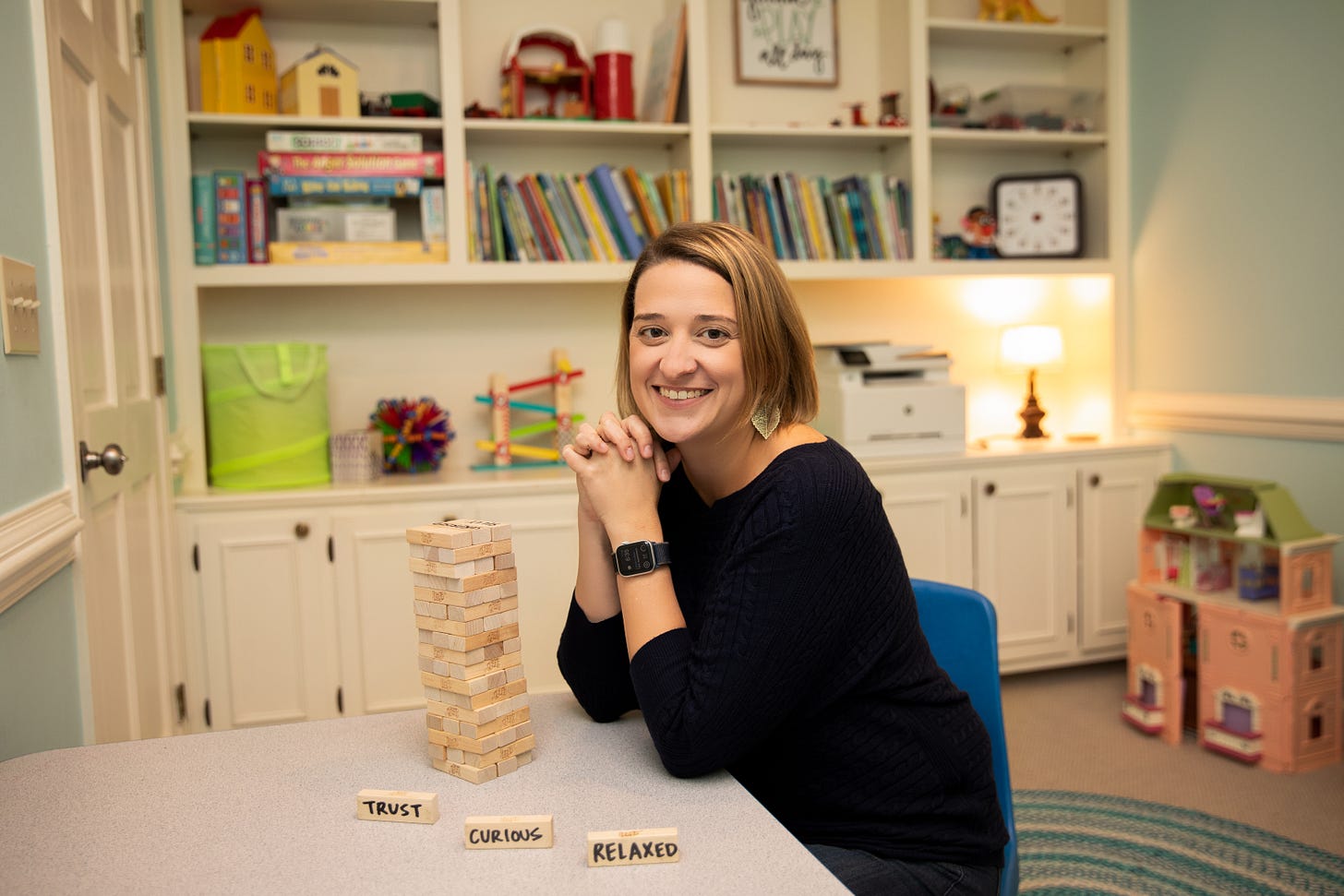
Parents, the holiday break is upon us. While I’m looking forward to having early mornings and homework nagging off the family agenda, kids being home in the winter for two, three, and sometimes four weeks in a row can feel daunting especially you are raising children with a high activity level or a high need for routine and structure. I want to share some tips to make the holiday break easier. So here goes…
There is quite a bit of advice out there encouraging parents to promote free time for their children. Free time allows children to feel what it's like to be bored, which gives them a chance to work out their differences with siblings and lets them solve their own problems. Free time encourages independence, increases social skills, and builds resilience. Truly, it does! Just read about it here, here, and here.
While exposure to free time is very beneficial for children who are READY to be independent, ALREADY have a solid understanding of their social world, and who are ABLE to trust that they are not in danger when something unexpected happens, free time can be difficult for children with weaknesses in executive functioning, emotional regulation, and social skills.
When Free Time Backfires
“The Blissful Solo Player”
For many autistic children, solo play feels like the safest kind of play. No one enters their space, no one throws off their plan, and if allowed to, they never have to transition away from this blissful play to do such boring things as use the bathroom or eat a snack. Also, many autistic children have superb memories of shows they may act out in play as well as heightened interests and an ability to hyper-focus that allows them to really enjoy their solo play. While parents of "the blissful solo player" might be grateful for this time to make dinner or talk on the phone, at the same time, they often have a gut feeling that too much time alone limits their child's opportunities for social practice and language development.
“The Never Leaves You Alone Player”
If your child falls into this category, you’re already nodding your head. These children are either too anxious to play alone, too distractible to settle into play, or say they are too bored on their own. Therefore, they persistently seek connection from parents who often feel they need to be in the same room or constantly entertain their child. These play patterns come from several different skill weaknesses.
Children experiencing anxiety may follow you around the house and need support to play in an area of the house where they cannot see or hear you. Children with executive functioning weaknesses often struggle to plan their play, begin their play, and sustain their attention long enough to stick with their play. This might look like a child who complains of being bored when you see lots of things for them to do or the child who loses interest quickly. Some children struggle to come up with ideas for play and this sometimes has to do with an executive functioning weakness in visualizing their play plan and getting started.
If forced to not bother their parents, these children may wander around and never settle into an activity, unlike a child who has the skills to plan, execute, and create in playtime. While it is a social strength that these children often ask for help and engage with parents, relying on parents too much can limit their opportunities for independent problem-solving that grows resilience. Also, parents of these children feel “touched out” and cringe when they hear “Mom!” one more time. If you feel this way, it’s time to add some structure to your family’s schedule. Here’s how to do it.
Supporting Your Child’s Free Time
Make a Routine When There Is No Routine
The first thing to understand is that your child’s negative behavior during a holiday break is nothing new. How do weekends go when there is not much going on? Are you able to work from home when your children are in the house? We know that children (and all humans) benefit from a routine, but there are some who really struggle to stay emotionally and behaviorally regulated without it.
The most important strategy when teaching free time is to actually schedule it like you would any other activity. As Kim Hughes, Conscious Discipline Master Instructor, explains: “Where there is chaos, add structure.” I often recommend to frame free time as “free-choice” time rather than an open-ended free for all where "the blissful solo player" may disconnect from the family and "the never leaves you alone player" either interrupts you relentlessly or wanders around aimlessly.
Having a general daily schedule during a long string of days at home is essential. But, make sure the schedule is not too detailed. If too detailed and something doesn’t go as planned, you could face the additional problem of a child’s emotional upset due to their rigidity when plans changes. Usually something like the following, written on a white board in your kitchen, does the trick:
Morning List (e.g., dressed, brush teeth, feed the cat)
Breakfast
Morning Activity
Snack
Free-Choice time (provide a menu with 3-5 options)
Lunch
Afternoon Activity
Snack
Free-Choice time
Dinner
Night time List (e.g., bath/shower, brush teeth, stories)
The trick is to make this routine consistent and then follow through with morning and afternoon activities, which are chosen by the parent (this can be errands or can be something fun!), and free-choice time, which is chosen by the child. Sit down with your child and create a free-choice menu where they can practice brainstorming things they like to do alone knowing that you will not be available for a certain amount of time.
How This Helps “The Blissful Solo Player”
"The blissful solo player" will benefit from a written routine with a few tweaks. This child will absolutely love free-choice time, so this is where we must help them expand their ideas by adding options to their list. The goal for "the blissful solo player” is to successfully transition away from free time play. You can support this transition by joining them just before the shift needs to happen. Engage with them, ask them to tell you what’s going on in their play, and then help them transition by moving on together. Create a visual STOP sign or PAUSE “button” to place on the play area to indicate that the play is “to be continued” so they know it’s time to move on but they can come back to it later. (Bonus tip: Teach siblings that when they see a STOP or PAUSE sign on a dollhouse or Lego creation that they do not touch it because it’s being saved for someone’s play later on).
How This Helps “The Never Leaves You Alone Player”
As the expert on your child, you will need to decide what an appropriate time span and location will be for free-choice time. Start with what you think your child CAN do and expand the time frame or distance from there. Some children will need for you to get them started on an activity, be reassured when something is a small problem they can solve on their own, or be reminded when it's okay to come get you for help. Use the time timer to let them know when you are available to be interrupted. Remember, you are teaching them how to be independent, so encourage and praise their successes. Let them know how helpful it was that you were able to call a friend, check your email, or feed the baby.
Also, your child may not fall exclusively into one of these categories, but they likely have moments when you can related to these ideas. Just remember, for most neurodivergent children, more structure is better, visuals are helpful even if your child is highly verbal, and consistent schedules are often magical.
A Note About Siblings
Some siblings are not developmentally ready to play without supervision. If you can’t walk away without someone getting hurt or calling someone a name, your kids might not yet have the social skills to consistently take turns, compromise, and stop and ask for help. Until at least one sibling has these skills, you will likely need to step in when play turns into name-calling, help them compromise, and then let them try again. For some families, a parent or sitter needs to be in the mix to help keep everyone safely playing. Again, remember: “Where there is chaos, add structure.” If siblings are not able to play without supervision, add in predictable alone time and supervised together time. Above all, have fun!
Let’s stay connected!
~Dr. Emily
P.S. Is your child a “blissful solo player” or a “never leaves you alone player?” Tell us in the comments and share a strategy!
I’m Dr. Emily, child psychologist and former school psychologist, and I’m on a mission to help parents and teachers be the best adults we can be for the neurodivergent kids and teens in our lives. This isn’t about changing the kids, it’s about changing us. Learn more with my resources for parents, teachers, and schools at www.learnwithdremily.com.
**All content provided is protected under applicable copyright, patent, trademark, and other proprietary rights. All content is provided for informational and education purposes only. No content is intended to be a substitute for professional medical or psychological diagnosis, advice or treatment. Information provided does not create an agreement for service between Dr. Emily W. King and the recipient. Consult your physician regarding the applicability of any opinions or recommendations with respect to you or your child's symptoms or medical condition. Children or adults who show signs of dangerous behavior toward themselves and/or others, should be placed immediately under the care of a qualified professional.**




